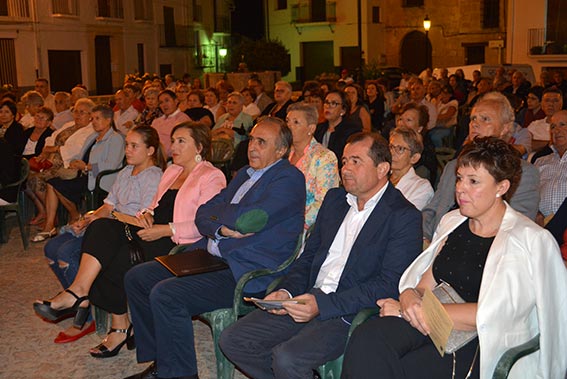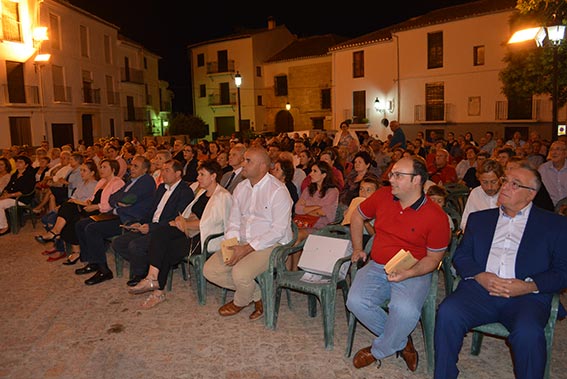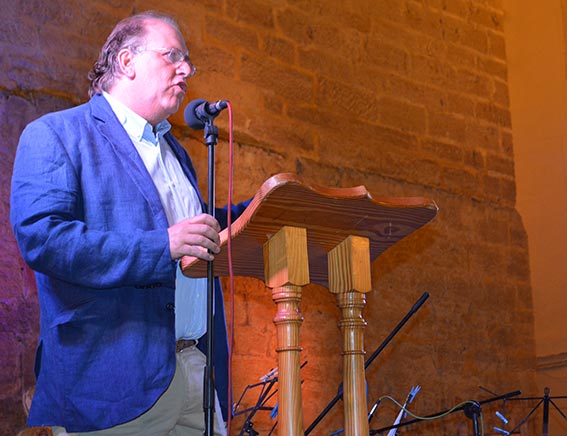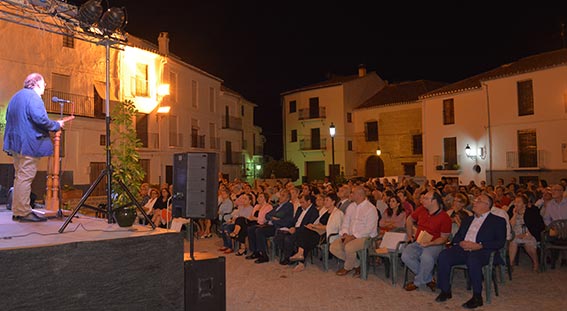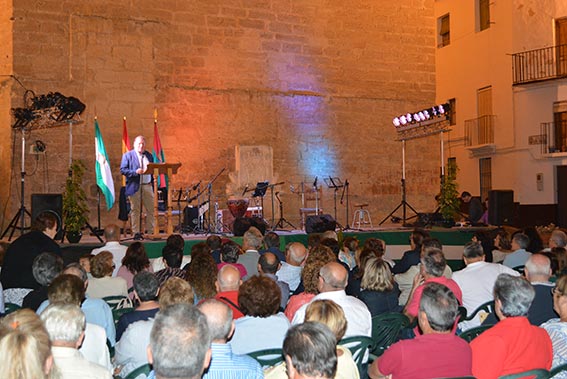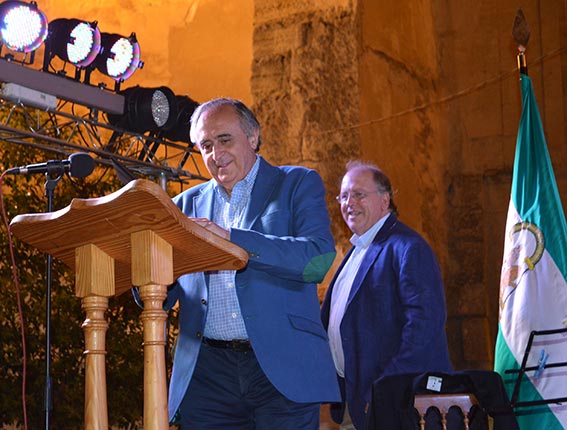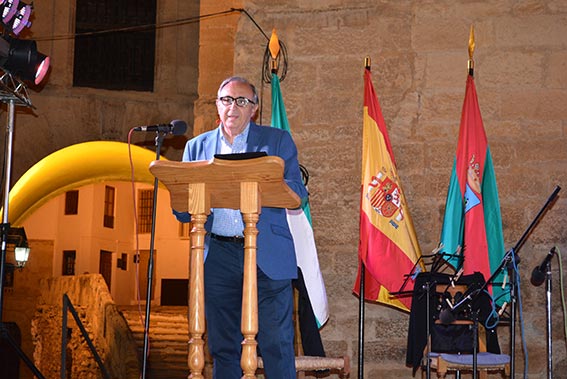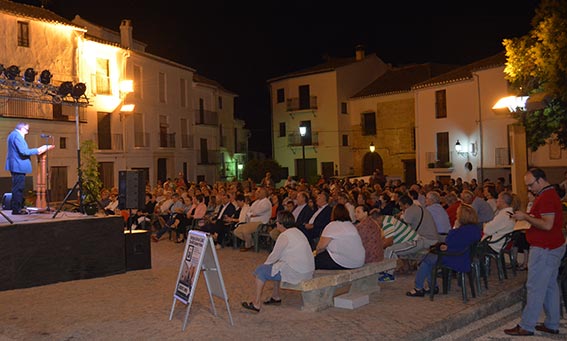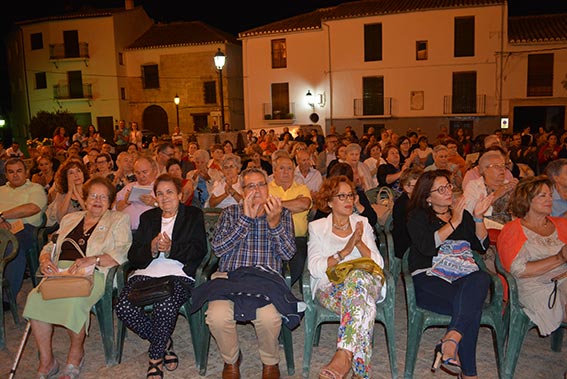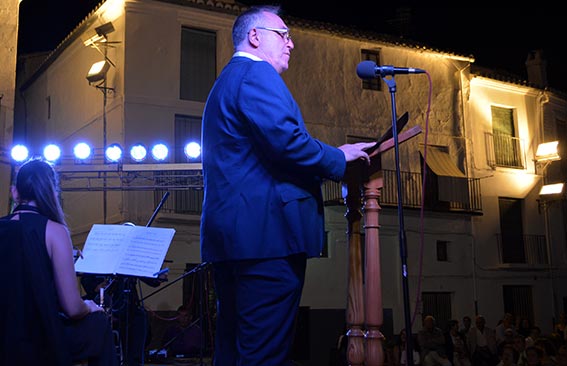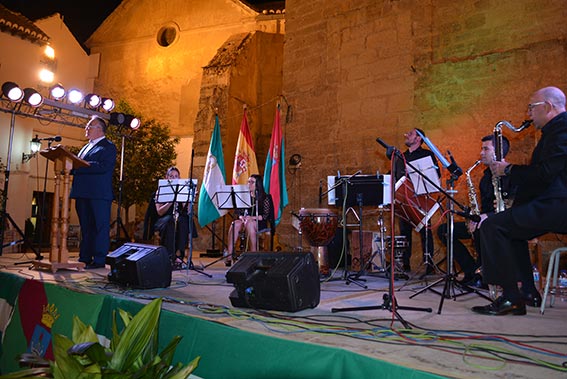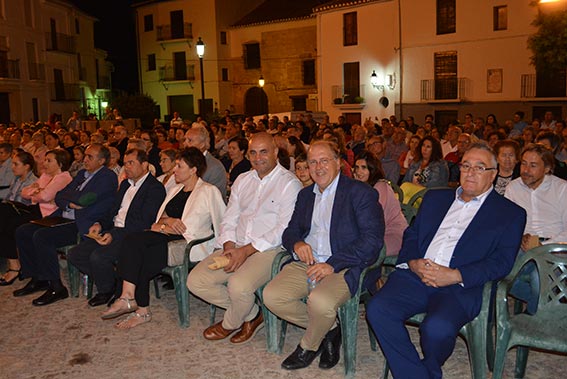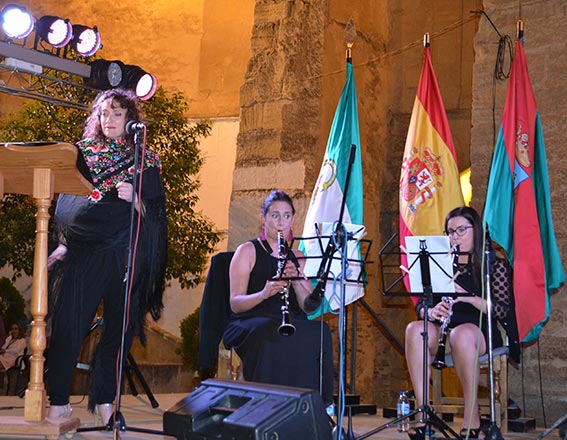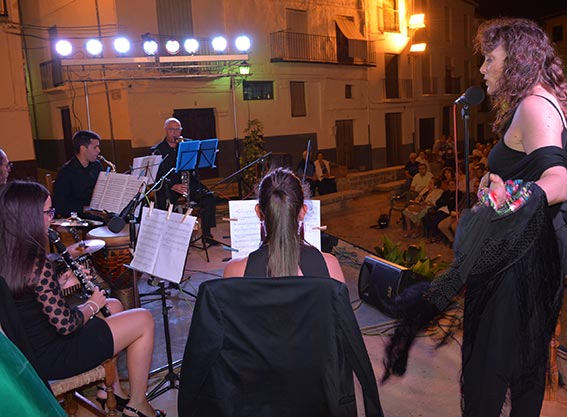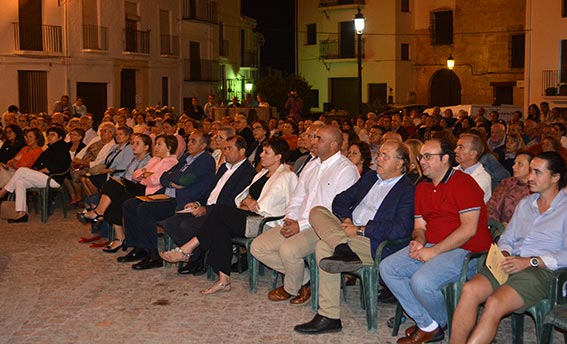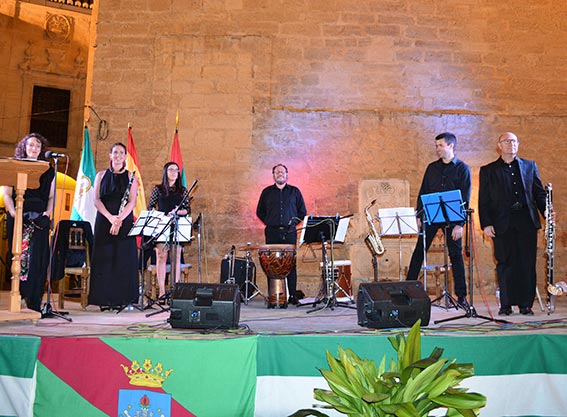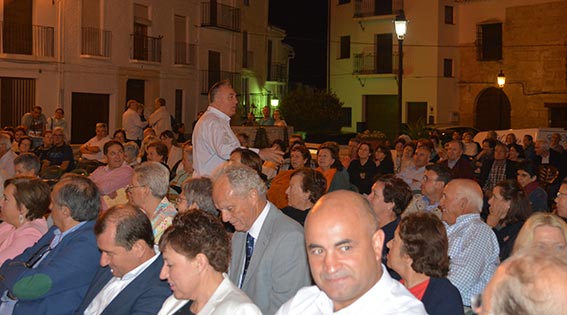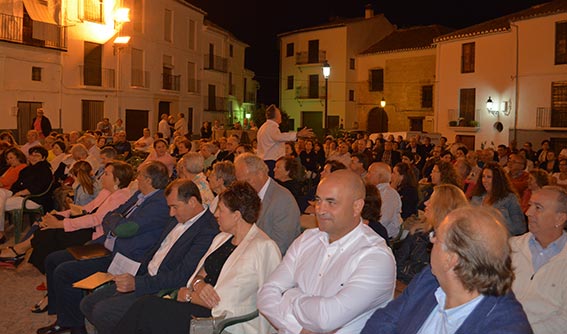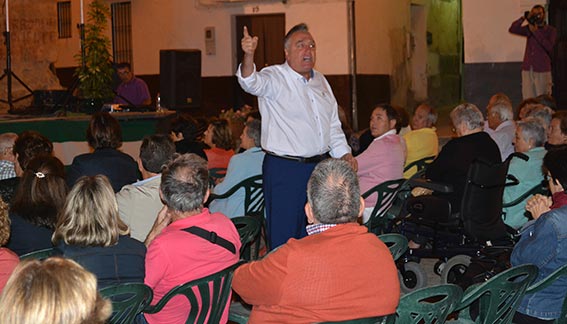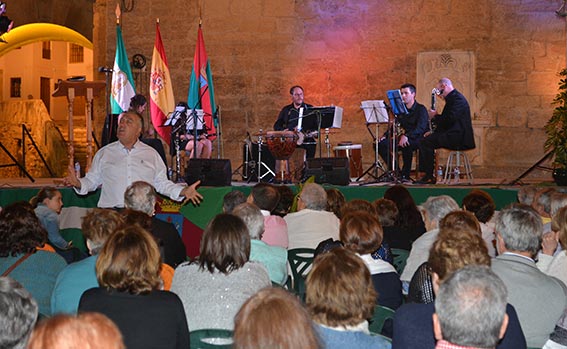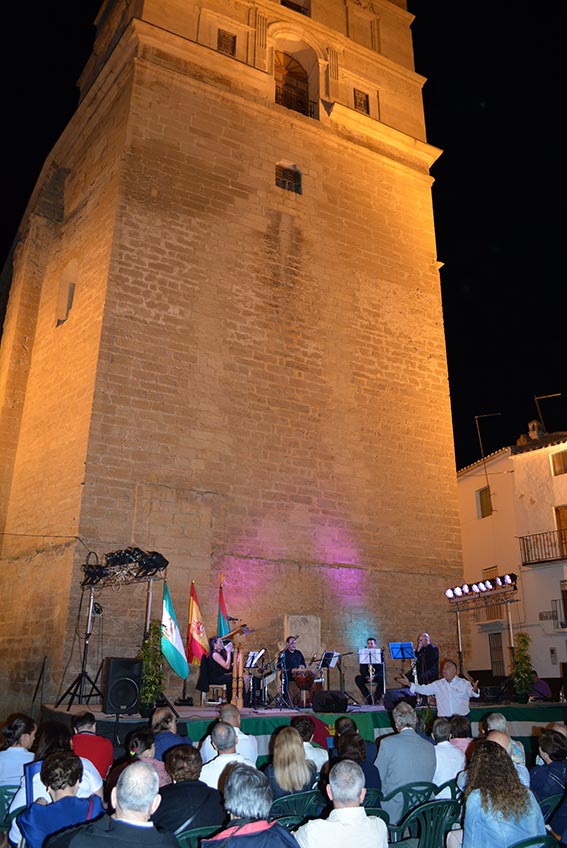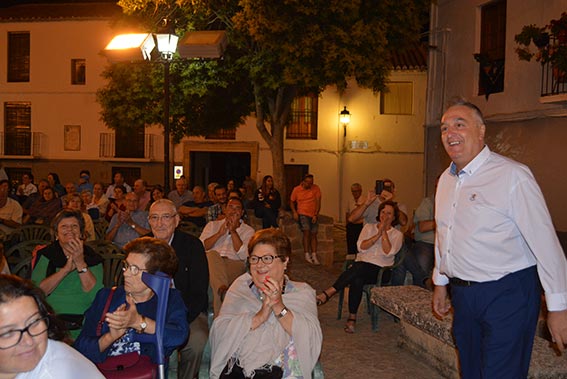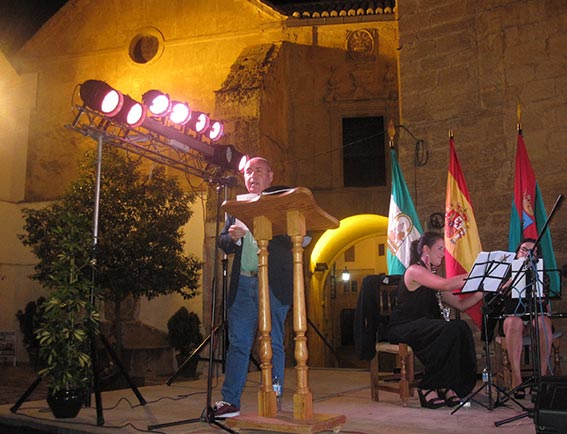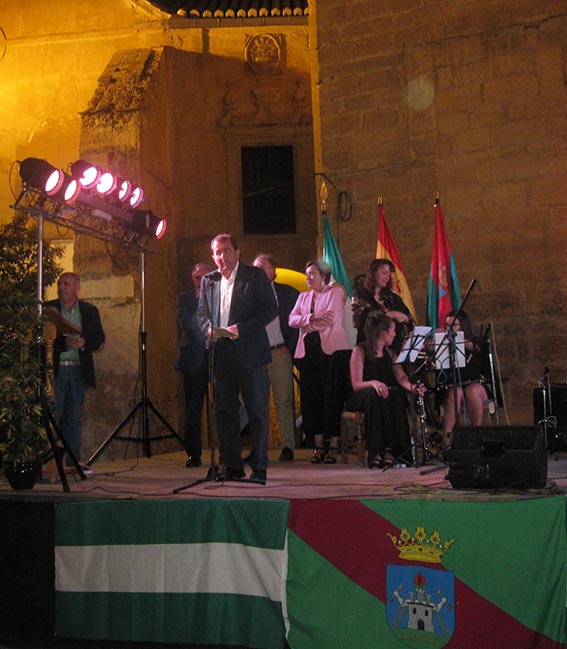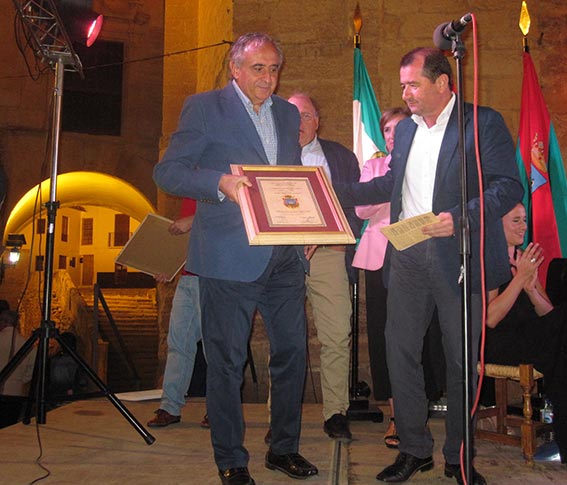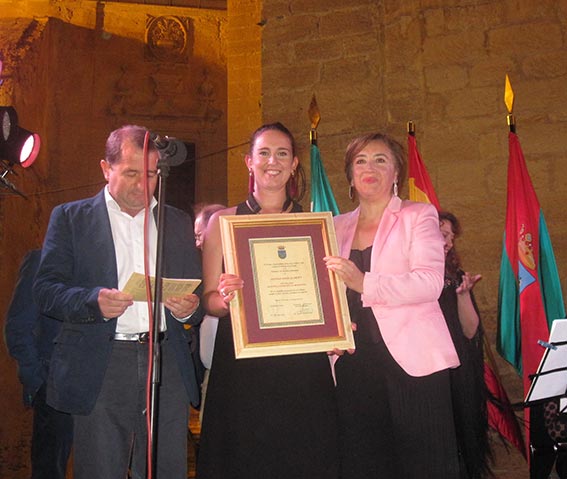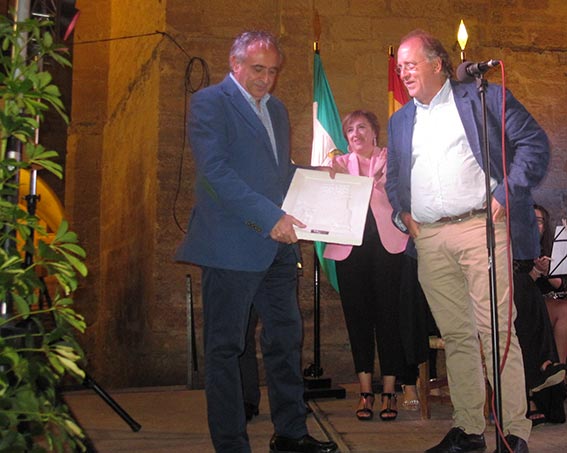
Intervention by Lorenzo Morillas Cueva. Guest of Honour. In Alhama, 12 August 2017.

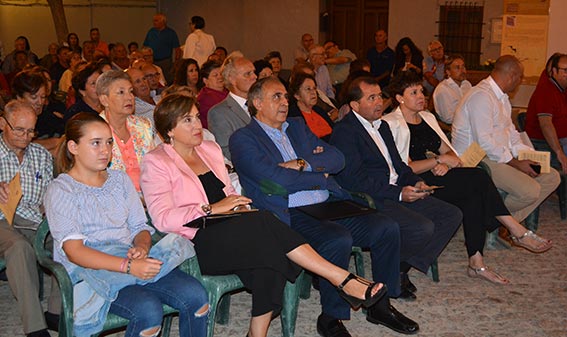
Let my first words express my intense gratitude to the institutions and people who have made possible my presence and intervention as a guest of honour. The honour is evidently mine because of such high distinction, as to enable me to address to briefly address the men and women of Alhama, during this act. Alhama, land of contrasts, illusions, of generosity and solidarity. Thank you to the H. Ayuntamiento de Alhama de Granada, to its Culture Councillor, to the Patronato of Alhameño Studies, to Alhama Communication, to Ignacio Benítez Ortúzar, to Raúl Gálvez Morales, and to our presenter Juan Cabezas Moreno.
It's the XXI Evening, Alhama, city of romances, and that means a lot. It means permanence in time, quality in its development, sustenance in a long and recognized tradition of the Alhameño people. It is a clear commitment for culture and history, for the defence of its values, for tradition and, at the same time, for the future of the people who have known with ease and commitment to remain active from their distant Neolithic origin, Roman to its Roman settlement, and it's Arab strengthening until the present time of the XXI century. This "hot water spring" - water as a fundamental reference in history and Alhameño life. As Fernando de Vergara and Cabezas wrote "among the elements of this world, none can be found in nature that is more admirable than water"; Fountains and Alhameños springs that disseminate their crystalline waters in forms of romances, ancestral wisdom, learned legacies, deep convictions, Roman-Arab-Christian transmission of tradition.
With a flag, that of Alhama, which has been able to combine in a balanced and committed way the influence of these two cultures and enriching civilizations essential to understand the being and development of the city of Alhama: Islamic-Nazari and Spanish Castilian, or as pointed out Andrés García Maldonado, master historian and writer of history and culture Alhameña, Muslim and Christian cultures. What it deepens with its two colours, in a mixture of past, present and future: the double green, yesterday Muslim and today Andalusian - with a crimson one - representing the fall of Alhama and the continued Christian presence. And in its centre the shield, clear influence of the latter, which symbolizes the special role that Alhama had in the Christian re-conquest and the castle as the incorporation of the city to the Crown of Castile, and also and subsequently, according to Garcia Maldonado, in the field on which it is fixed in the drawing of the "Letter of Privilege and Confirmation" that King Carlos II granted to Alhama in 1689, in relation to the fort that was Alhama; the integration of the fortress city of Alhama to the Kingdom of Granada; Three scales, heroic resistances of the defenders, once conquered by the Christians - the 28 of February of 1482 -, with which begins the war of Granada and that in the words of Sánchez Albornoz "begins the agony of the Moorish Spain". Almost a decade later, on November 25, 1491, the last Nazari King Boabdil and the Catholic King and Queen signed the Capitulations with which the Granada war was ended, and with it the re-conquest concluded.
Three hard sieges to which the city was submitted, by the Nazari forces, in unsuccessful attempts to recover it, between March and August of 1482; Arms with the two keys, dominion and Christian courage, arms with armour, and the keys to the two main doors that the city had, Granada and Malaga; In addition, according to Fernando de Vergara, it also represents the fundamental moment that the taking of Alhama was the key for the conquest of Granada; The crown, open, corresponding to the town councils of a city recognized as such.
The hardship of the capture of Granada from the Nazari kingdom was manifested in several romances, the most famous, known and quoted, which I will then allude to, is that of Woe is me, Alhama!, Romance for the loss of Alhama, now I will say the one known as Moor Alfaqui, Moor Alfaqui.
Moor Alfaqui! Moor Alfaqui!
Though thy beard so hoary be,
The King hath sent to have thee seized,
For Alhama´s loss displeased.
And to fix thy head upon
High Alhambra´s loftiest stone;
That thus for thee should be the law.
Though thy beard so hoary be,
The King hath sent to have thee seized,
For Alhama´s loss displeased.
And to fix thy head upon
High Alhambra´s loftiest stone;
That thus for thee should be the law.
“Cavalier and men of worth!
Let these words of mine go forth!
Let the Granada monarch know,
That to him I nothing owe
He was in Antequera attending his sisters wedding.
Fire burns the wedding celebrations and who called me upon them.
The King gave me permission that I asked for, fifteen days, and he gave me three weeks permission.
“But on my soul Alhama weighs,
And on my inmost spirit preys;
And if the King his land hath lost,
Yet others may have lost the most.
Sires have lost their children, wives their Lords, and valiant
men their lives!
One what best his love might claim
Hath lost, another wealth, or fame.
“I lost a daughter in that hour who was the flower of Granada.
He who has her captive Marques of Cadiz is called.
Doubloons a hundred I would pay.
And think her ransom cheap that day”
The answer I have received is that my daughter is Christian
and the name she has received is Doña Maria of Alhama.
The name that she has is Mora Fatima.
And as these things the old Moor said,
They sever´d from the trunk his head;
And to the Alhambra´s wall with speed
Twas carried as the King decreed.
And in spite of all this - and of the profound changes that the conquest in the very face of the city took, for example, the replacement of mosques by churches, old souks for open plazas - the very noble and very loyal city of Alhama, knew how to maintain, enriched by the coexistence of styles, and has managed to persevere and not give up the remarkable Arab contributions, its culture, its way of being and its idiosyncrasy.
Generous confluence that marks a commitment of a city, with sensitivity to other cultures that had so much influence in its development. Fortunately it has not been forgotten, as explained by García Maldonado, because it was the Muslims who named Alhama, enriched the place, from the most diverse perspectives, gave it prestige of a great city, preserved it for centuries beautiful and attractive, as wanted lady, defended it and tried to recover "their" Alhama, leaving in the longed but barren way, hundreds of his best soldiers.
And I return to the beginning, to the evocation of rejoicing. The first of them and again to be here tonight, but now in concrete: in this Square of the Prisoners - denomination derived from the building that was prison of the city and that today is a sample of positive transformation has become a Centre For the Interpretation, Knowledge, Dissemination of the history and Culture of Alhama de Granada -; known before as Plaza Real / Plaza Mayor de Alhama, although legally seems to follow with this last one of the denominations mentioned, for others, more like vindication of a relevant position, place of the Three Cultures. Be that as it may, and evidently, it is now known as the Prisoners' Square, what I want to mean is that it has been permanent and ancestral witness of what we gather in it, the romances, back in the Middle Ages, through which, through oral transmission, a part of their history, of their feelings, of their heroics, was transferred to the people, if not their love affairs, their troubles, or their own fantasies.
The second, my intervention, almost returning to the past, as a modern romance of a renewed juggler, not lyrical but simply narrative, but based on the word, oral transmission, which means proximity, physical approach to the people, which fills me of pride and complacency.
And the third, which in these XXI evening of the romances, in addition to its own meaning, commemorates, as a song to freedom, the 75th Anniversary of the death of the outstanding and brilliant poet Miguel Hernández, whose life was cut short. He died at 32 years in a dark and sombre prison in Alicante from the aftermath left by the fratricidal Civil War and its subsequent imprisonment, but long, at least in its quality, poetic work. Referring to the ideological commitment. As Pablo Neruda wrote to remind Miguel Hernandez that he disappeared in the dark and remember him in full light, it is a duty of Spain, a duty of love. And today, tonight, a town, with an exquisite cultural trajectory, of that Spain, to the south, in our Andalusia, that Andalusia in which our anthem requires us to the Andalusians. "Ask for land and freedom. For a free Andalusia, Spain and Humanity! " This town called Alhama de Granada is doing exactly what the poet from Alicante wanted for the freedom and justice, in his memory.
Following with Neruda, Miguel Hernandez probably did not have the southern overhead light, but a light of earth, stony morning, thick light of honeycomb awakening. With this hard material like gold, live like blood, he traced his lasting poetry, which could not cut the cruel death in his youth.
Call is to the youth
Blood that is not flowing,
youth that is not brave,
is not blood or youth,
no shine or flourishment.
bodies that are born defeated
defeated and grey they die
they are born with a century in age
and they are old when they are born.
As you may have noticed, I am not a historian, if I am an apprentice historian, I am a lawyer, a criminal lawyer. But I enjoy researching and investigating about the beautiful things, of interest, of transcendence, of beautiful things, quality works, references.
About beautiful cities, Alhama de Granada, historic cities, Alhama de Granada, cultural cities, Alhama de Granada, cities committed, Alhama de Granada, cities of solidarity, Alhama de Granada. I am not from Alhama, I am from Jaen, the silver city Jaén of Machado, and a connection with the remembered Miguel Hernández with his Andaluces de Jaén, written in 1937.
Andaluces from Jaen,
lofty and proud olive growers
My soul ask, To whom do these olives belong?
Jaen wake up brave,
on your moonstones
Don´t ever allow to be slave
with those silvery olives.
lofty and proud olive growers
My soul ask, To whom do these olives belong?
Jaen wake up brave,
on your moonstones
Don´t ever allow to be slave
with those silvery olives.
I am not, Alhameño, but I have learned to know and to love Alhama de Granada not so much with physical presence, but also, because of the passion for Alhama of my colleague and friend Nacho Benítez, guest of honour in the XIII Evening, 2009, an illustrious Alhameño of heart and presence. With him I have travelled over the word and the mind, the illusion and the knowledge, the joy of knowing and the desire to know, Alhama de Granada.
I have to start with its beautiful contours, those on which the walker advances self-absorbed, curious, excited to reach the majesty of Alhama. To which Garcia Maldonado points out in his book "The Baths of Alhama and the Apology of Fernando Vergara" how nature itself enriched the city with surroundings full of many different sounds and properties, so that this place, for its own pleasure and fertility, seems to have been devoted to voluptuousness and gratitude. He who sees it will see it planted with the abundance of the goods produced by the land, he will see the sublime rocks, placed on the high and steep mountains, valleys and fountains; Everything so that these places do not lack anything to fill the pleasure of sight and recreation of the mind.
Alhama, "hanging, as detailed by, Teófilo Gautier, on a huge rock or beak like an eagle's nest", is shown in the eyes of the traveller also like the city of the Tajos, that set of canyons and sandstone cuts, product of the erosion of the river Alhama and the rocks detachments fundamentally as a consequence of the earthquakes suffered by the city throughout its history. Beneath the astonished eyes of the observer, with so much beauty, the river of the same name to the city - again the water flowing, free, transparent, fresh, endowed, among riverside woods, malls and willows. It is located in the Sierra de Tejeda, Almijara and Alhama Natural Park, with a spectacular landscape, with numerous ridges and deep valleys, located on the Alhama River. It is located between the provinces of Granada and Malaga and remembers from this aspect the fundamental role of the historical Alhama as a border town, and not only, which is already a lot, for its hospitable and restful character but also for the charm of its good people, its majestic monuments, its splendid corners, its prolific fountains, ditches, mills - among them the magnificent Almohade pool, of Andalusian origin, a fascinating place for the mixture of its attractive history, water as a special value and the light or the source of Caño Wamba, built in 1533, in a Renaissance style; all this makes me visualize in time the old Nazari route, remembered as usual and mythical way of union between both, set by minstrels and narrators of romances that made the journey, a magical walk, despite their not hidden insecurities.
Approximately two kilometres from Alhama, coming from the road to Granada, is another important Alhameño reference, of great attractiveness and projection, its thermal baths that, besides its importance and international projection as such, is another significant proof of the settlement of cultures and civilizations in this enviable land Alhameña. Thus, in the quotation of García Maldonado and Fernando de Vergara, its origin must be identified with the same presence of man in these lands, from the Middle Palaeolithic, Neolithic, whose men and women lived in the nearby Caves of the Women and the Water, other standards of the history of Alhama, of the Phoenicians and, above all, of the Romans. It is important to emphasise the Roman bridge near the thermal and Arab baths. The reality, in any case, is that the confluence of all of them in terms of their form and, fundamentally, the contribution of nature itself, in its depth, which provided them with abundant sources of hot water emanating from them, and they warm themselves, without any artificial contribution - from the miracle of nature, Garcia Maldonado points out.
And enter the city, in the very beautiful, noble, loyal, hospitable, city of Alhama, to its old town, historical artistic set, entranced by so much exquisiteness, therefore history, attentive to all its particularities, all its beauties in all their corners. They are many. As it cites this Place of the Prisoners that I have already referenced and in it it's Jail, constructed in 1674 under the mandate of Carlos II. A special mention deserves, in the context where I am moving, the Major Church of Santa Maria de la Encarnación that was built, beginning in 1505, on top the Great Mosque, by order of the Catholic Monarchs, in a display of religious and political power of the winners. It is the first Christian Church consecrated in the ancient Kingdom of Granada, after the conquest by the Christians. It is a splendid work of late Gothic and Renaissance style. This is how Garcia Maldonado sees it "dignifies and externalizes the new image of the city to the point where, as the crown was running with the building costs, then the construction is translated, at an artistic and decorative level, into two actions: the choice of Gothic as an artistic style and the Gothic epigraphy and real laudatory elements of the Catholic Monarchs, all as a direct reference to the taking of Alhama." Next to it, we cannot miss a damaging memory of the blackest history of Spain, the House of the Inquisition, Baroque style and as part of its negative symbolism on the facade appears a small sculpture in bas-relief of the devil of that.
Then the Castle, of Arab origin but remodelled at the beginning of the last century; Churches and convents, built as a sign of Christian fervour and as a relentless testimony to the Christianization of the city, after its capture: the sixteenth-century Renaissance church of Nuestra Señora del Carmen, with baroque decoration, the old Convent of the Shoed Carmelites, Convent of San Diego, Church of the Angustias. To add, from a more secular perspective, the Hospital de la Reina or Royal Hospital - in this second of equal nomination to the existing one in the city of Granada today soothes the Rectorate of the University-, of renaissance architecture, the first blood hospital, building which was the home of the Cadiz of Alhama - currently in its interior are the headquarters of the Association of Andalusian Thermalism and the Centre for the Exhibition of Crafts of Alhama de Granada; the Communal Barn or pósito, raised in the first half of century XVI, was built on the existing synagogue.
Many other peculiarities I could include about buildings, nature, sources, landscapes, waters, Alhameñan traditions; but I cannot and should not abuse your patience and your understanding, especially since I have already had the audacity to speak of issues that you know better than I do and that are alive in your splendid daily life, for which I have scratched in recklessness; I wanted, however, to do so to give external testimony, as a guest dazzled by the excellence, culture and historical commitment of Alhama de Granada.
This evening event is called Alhama city of romances and is dedicated to Miguel Hernandez, and with it I will finish. City, history, romance. The latter is a type of poem characteristic of the Spanish, Iberian and Spanish-American literary tradition. Its popular splendour, as I have advanced, is produced in the fifteenth century. They are very varied in their theme: historical, fictional, lyric, epic, border. The last one gives me entrance to the Alhama romances, whose banner, almost an anthem of a painfully accepted loss that changed the life of Alhama is the Woe is me, Alhama!, that not by being heard and known has lost interest in its reading; fundamentally if, as I will do, I put it in comparison with another version
The Moorish King rides up and down,
Through Granada´s royal town,
From Elvira´s gate to those
Of Bivarambla on he goes.
Woe is me, Alhama!
Letters to the monarch tell
How Alhama´s city fell:
In the fire the scroll he threw,
And the messenger he slew.
Woe is me, Alhama!
He quits his mule,
And mounts his horse,
And through the street directs his course;
Through the street of Zacatin
To the Alhambra spurring in.
Woe is me, Alhama!
When the Alhambra walls he gain´d,
On the moment he ordain´d
That the trumpet straight should sound
With the silver clarion round.
Woe is me, Alhama!
And when the hollow drums of war
Beat the loud alarm afar,
That the Moors of Vega and Granada
Might answer to the martial strain.
Woe is me, Alhama!
Then the Moors, by this aware,
That bloody Mars recall´d them there,
One by one, and two by two,
To a mighty squadron grew.
Woe is me, Alhama!
Out then spake an aged Moor
In these words the king before,
“Wherefore call on us, oh King?
What may mean this gathering?”
Woe is me, Alhama!
“Friends! Ye have, alas! To know
Of a most disastrous blow;
That the Christians, stern and bold
Have obtained Alhama´s hold
Woe is me, Alhama!
Out then spake old Alfaqui,
With his beard so white to see,
“Good King! Thou art so justly served,
Good King! This thou hast deserved.
Woe is me, Alhama!
“By thee were slain, in evil hour,
The Bencerrages, Granada´s flower;
And strangers were received by thee
Of Cordoba the Chivalry.
Woe is me Alhama!
“And for this, oh King! is sent
On thee a double chastisement:
Thee and thine, thy crown and realm,
One last wreck shall overwhelm.
Woe is me, Alhama!
Jose Zorrilla in his work "Granada Oriental poetry" preceded by the Al-Hamar legend, also poetically narrates the loss of Alhama and the death of the messenger by Muley-Hacen decision, on the same Woe is me, Alhama, but figuring it from the Muslim version
Standing, next to a peristyle pillar,
He saw a man whose face was strange to him,
Pale, bloody, silent,
And of a slow gesture, but calm
He smiled as he saw him, satisfied.
Of finding in whom the cholera of the chest
Download, and with terrifying calm
Muley went to him. Standing right,
Contemplating him boldly, with a fixed eye,
The man waited for him, and until he arrived
The angry King thus said to him:
"Who are you?" "No one," replied the man.
From the wrath of Muley felt the flame
Raising to his face, and with fury trembling:
"Your race," he said, "your country, your name?"
And with an accent of full sadness
To the King the man replied serene:
"It has no name anymore, country does not have
"Neither family nor tribe claims him
"Because of him that, his country leaving
"Slave, fleeing from his homeland comes
"To count the debacle with which he is infamous.
"My people lie, Amir, dead or captive;
"And he only sees in me that he escaped alive
"Of the tremendous desolation of Alhama".
The Monarch paled upon hearing the fatal news
His messenger
Smiled with sardonic bitterness
Thus following: - "Amir, my soul is pure
"Of treason: I fought with the frontline:
"More when everything was lost, my scarcity
"Breath I took advantage in the hope
"Of coming to your feet and you with your power,
"Ask you, not favour but revenge;
"But not for me: I do not want it:
"Without honour and without a home I´ll die, I prefer
"Alhama was lost because of your abandonment
"And his whole people cried out against thee:
"But I am a true believer
"And in thee looking upon Allah upon thy throne
"In the name of my race I forgive you,
"Said the loyal; and with sublime calm
In his chest the dagger burying
Expired, good Muslim, commending
His vengeance to his King, to God his soul.
The most solemn silence reigned one point:
Then, speaking Muley to himself,
He said: "Yes, the truth is perennial:
"The appearance ... Alhama ... everything is true!
And He is free now! -confuse the abyss!
"It would have been better at birth to have killed him!"
Romances, between the history and legend, sadness and lost battle, between government and cruelty, between doubt and loyalty. Romances that enhanced and continue to project the image of Alhama and its name beyond our frontiers.
Evenings like tonight and the previous twenty contribute in great measure to bring to the attention of people, the history, to revive the interaction and to mix and to join the oral and the written records, the different cultures. With great work behind them and good results.
I finish now with a poem from Miguel Hernandez, who we commemorate today, in his line of liberty, cries of freedom in difficult times, to conclude this act.
The hands.
Two types of hands confront each other in this life.
they come straight out of the heart, at the end of the arms
ending in the light of hurt,
fighting, like fists, like claws.
The hand is the tool of the soul, its message
and in it the body has its combat tool
raise your hands like a wave
men of my seed.
Thank you ladies and gentlemen for your attention and understanding.
Be sure that my heart there is a special place for an imaginary lecture of Alhama de Granada.
Many thanks
Translated by Alina and Laurence Strong
>>> Spanish version. Versión en español.
